Papers by Katsunori Wakabayashi
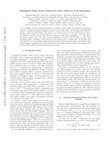
Physical Review B, 2019
In crystalline systems, charge polarization is related to Zak's phase determined by bulk band top... more In crystalline systems, charge polarization is related to Zak's phase determined by bulk band topology. Nontrivial charge polarization induces robust edge states accompanied with fractional charge. In Su-Schrieffer-Heeger (SSH) model, it is known that the strong modulation of electron hopping causes nontrivial charge polarization even in the presence of inversion symmetry. Here, we consider a bi-atomic honeycomb lattice to introduce such strong modulation, i.e. A3B sheet. By tuning hopping ratio and onsite potential difference between A and B atoms, we show that topological phase transition characterized by Zak's phase occurs. Furthermore, we propose that C3N and BC3 are the possible realistic materials on the basis of first-principles calculations. Both of them display topological edge states induced by Zak's phase without spin-orbital couplings and external fields unlike conventional topological insulators.
Meeting Abstracts of the Physical Society of Japan (Nihon Butsuri Gakkai koen gaiyoshu), 2012
Meeting Abstracts of the Physical Society of Japan (Nihon Butsuri Gakkai koen gaiyoshu), 2013

Physical Review B, 2020
The optical properties of triptycene molecular membranes (TMMs) under the linearly and circularly... more The optical properties of triptycene molecular membranes (TMMs) under the linearly and circularly polarized light irradiation have been theoretically studied. Since TMMs have the double-layered Kagome lattice structures for their π-electrons, i.e., tiling of trigonal and hexagonal-symmetric rings, the electronic band structures of TMMs have non-equivalent Dirac cones and perfect flat bands. By constructing the tight-binding model to describe the π-electronic states of TMMs, we have evaluated the optical absorption intensities and valley selective excitation of TMMs based on the Kubo formula. It is found that absorption intensities crucially depend on both light polarization angle and the excitation position in momentum space, i.e., the momentum and valley selective optical excitation. The polarization dependence and optical selection rules are also clarified by using group theoretical analyses.
Extended Abstracts of the 2010 International Conference on Solid State Devices and Materials, 2010
AIP Conference Proceedings, 2007
The ferromagnetic system with orbital hybridization and onsite spin‐orbit coupling shows finite a... more The ferromagnetic system with orbital hybridization and onsite spin‐orbit coupling shows finite anomalous and spin Hall conductivity. In this paper, we study the edge effect on charge and spin transport properties in quasi‐one dimensional anomalous Hall system. It is found that the existence of the intriguing spontaneous edge spin current which flows even in the absence of the internal magnetic field, unless either orbital hybridization hopping or spin‐orbit interaction is turned off. The origin of the surface spin current is the consequence of ...
AIP Conference Proceedings, 2006
Abstract. The Luttinger sum rule is usually considered for Landau Fermi liquids in which the sing... more Abstract. The Luttinger sum rule is usually considered for Landau Fermi liquids in which the single particle Green's function G (k, 0) changes sign at the the Fermi surface by passing through infinity. However the general proof allows also for a sign change at which G has a zero. A recent analysis by Konik and coworkers considers a model of 2-leg Hubbard ladders weakly coupled by a small long range interladder tunneling. At half-filling a semimetallic state with small Fermi pockets is induced beyond a threshold tunneling strength. The sign ...
Physical review letters, Jan 17, 2017
We present a two-dimensional (2D) lattice model that exhibits a nontrivial topological phase in t... more We present a two-dimensional (2D) lattice model that exhibits a nontrivial topological phase in the absence of the Berry curvature. Instead, the Berry connection provides the topological nontrivial phase in the model, whose integration over the momentum space, the so-called 2D Zak phase, yields a fractional wave polarization in each direction. These fractional wave polarizations manifest themselves as degenerated edge states with opposite parities in the model.
Journal of the Physical Society of Japan, 2003
Mol Cryst Liquid Cryst, 1998
Scientific reports, Jan 17, 2015
Scanning tunneling microscopy (STM) observation reveals that a cyclic thiazyl diradical, BDTDA (=... more Scanning tunneling microscopy (STM) observation reveals that a cyclic thiazyl diradical, BDTDA (= 4,4'-bis(1,2,3,5-dithiadiazolyl)), forms a well-ordered monolayer honeycomb lattice consisting of paramagnetic corners with unpaired electrons on a clean Cu(111) surface. This BDTDA lattice is commensurate with the triangular lattice of Cu(111), with the former being 3 × 3 larger than the latter. The formation of the BDTDA monolayer structure, which is significantly different from its bulk form, is attributed to an interaction with the metal surface as well as the intermolecular assembling forces. STM spectroscopy measurements on the BDTDA molecules indicate the presence of a characteristic zero-bias anomaly centered at the Fermi energy. The origin of this zero-bias anomaly is discussed in terms of the Dirac cones inherent to the honeycomb structure.
Physical Review B, 2015
Retardation effects (REs) are known to cause a crossover from linear to sublinear behaviors in th... more Retardation effects (REs) are known to cause a crossover from linear to sublinear behaviors in the dispersion relation of two-dimensional (2D) plasma waves at long wavelengths. In the present work, we systematically analyze REs on plasma waves in both 2D and 1D electron gases, and we clarify the experimental conditions for observing the crossover. We show that graphene is the only material that might gratify the conditions with current technology. Although it closely imitates graphene, the surface of 3D topological insulators is found to be unsuitable for this purpose due to strong electronic scattering by intrinsic disorder. We also show that the crossover, though theoretically possible, virtually never occurs in 1D plasma. In addition, the relevance of our results to terahertz plasmonics is discussed.
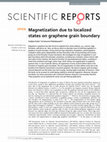
Scientific Reports, 2015
Magnetism in graphene has been found to originate from various defects, e.g., vacancy, edge forma... more Magnetism in graphene has been found to originate from various defects, e.g., vacancy, edge formation, add-atoms etc. Here, we discuss about an alternate route of achieving magnetism in graphene via grain boundary. During chemical vapor deposition of graphene, several graphene nucleation centers grow independently and face themselves with unusual bonding environment, giving rise to the formation of grain boundaries. We investigate the origin of magnetism in such grain boundaries within first-principles calculations, by letting two nucleation centers interact with each other at their interface. We observe formation of unprecedented point defect, consisting of fused three-membered and larger carbon rings, which induces net magnetization to graphene quantum dots. In case of periodic lattices, the appearance of array of point defects leads to the formation of magnetic grain boundaries. The net magnetization on these defects arises due to the deviation from bipartite characteristics of p...
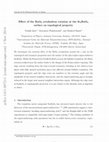
Journal of the Physical Society of Japan, 2014
We investigate the rotation effect of the RuO 6 octahedron around the c axis on the topological a... more We investigate the rotation effect of the RuO 6 octahedron around the c axis on the topological and transport properties near the surface of the spin-triplet superconductor Sr 2 RuO 4. While the Fermi level of bulk Sr 2 RuO 4 is near the Lifshitz transition, the RuO 6 rotation realized near the surface leads to the change of the Fermi surface topology. The edge current resulting from the time-reversal symmetry breaking in the chiral p-wave phase with fully opened excitation gap is less affected around Lifshitz transition. The topological property and the edge state are sensitive to the rotation angle and the amplitude of the nearest neighbor interaction, and the superconducting gap is strongly reduced in the larger next nearest neighbor interaction region. Although the edge state in Sr 2 RuO 4 is topologically protected, it is not robust to the disorder such as impurity or defect.
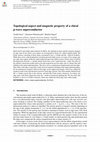
Proceedings of the International Conference on Strongly Correlated Electron Systems (SCES2013), 2014
Motivated by spin-triplet superconductor Sr 2 RuO 4 , the topological aspect and the magnetic pro... more Motivated by spin-triplet superconductor Sr 2 RuO 4 , the topological aspect and the magnetic property of edge states in the chiral p-wave phase are investigated by means of a ribbon-shaped model. The Fermi surfaces consisting of three sheets correspond to the α-β-bands and the γ-band of Sr 2 RuO 4. While there exists a full quasiparticle excitation gap in the bulk system, two types of low-energy gapless edge states appear inside the superconducting gap in the ribbon system, which consist of almost flat dispersions from the α-β-bands and the linear ones at the Γ point from the γ-band. The effect of the repulsive interaction readily leads to the spin magnetism near the edges, due to a Stoner-like spin splitting in the superconducting phase. This gives rise to a spontaneous magnetization near the edges. Since there is the edge current due to time reversal symmetry breaking in the superconducting phase, the net spontaneous magnetic field near the edges can be suppressed strongly, which may explain the negative results in the experimental search for chiral edge currents. The Chern number obtained from the α-β-bands cancels due to the electron-and hole-like Fermi surface characters. In contrast, the edge states with linear dispersions from the γ-band are protected topologically. We also show that Sr 2 RuO 4 is close to a Lifshitz transition, which may render the chiral edge states rather fragile.
Japanese Journal of Applied Physics, 2014
Physical Review B, 2015
We analytically study vacancy effects on electronic and transport properties of graphene nanoribb... more We analytically study vacancy effects on electronic and transport properties of graphene nanoribbons and nanodots using Green's function approach. For semiconducting systems, the presence of a vacancy induces a zero-energy midgap state. The spatial pattern of the wave functions critically depends on the atomistic edge structures and can be used as an unambiguous probe of the edge structure. For metallic systems, the midgap vacancy state does not exist. In these systems, the vacancy mainly works as a source of electronic scattering and modifies electronic transmission. We derive that the electronic transmission coefficient can be written as T = cos 2 (α), where α denotes the phase angle of the on-site Green's function at the vacancy site of the ideal systems. At small energies, T exhibits distinctly different functional form depending on edge structures.
Physical Review B, 2014
Bulk modes (BM) are basis solutions to the Schrödinger equation and they are useful in a number o... more Bulk modes (BM) are basis solutions to the Schrödinger equation and they are useful in a number of physical problems. In the present work, we establish a complete set of BMs for graphene ribbons at arbitrary energy. We derive analytical expressions for these modes and systematically classify them into propagating or evanescent mode. We also demonstrate their uses in efficient electronic transport simulations of graphene-based electronic devices within both the mode-matching method and the Green's function framework. Explicit constructions of Green's functions for infinite and semi-infinite graphene ribbons are presented.
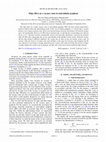
Physical Review B, 2014
The edge effect on a single vacancy state of semi-infinite graphene (SIG) has been studied using ... more The edge effect on a single vacancy state of semi-infinite graphene (SIG) has been studied using Green's function method within the tight-binding model. In the case of infinite graphene, it is known that a vacancy induces a zero-energy resonance state, whose wave function decays inversely with distance (R) from the vacancy and is not normalizable. However, for SIG with an armchair edge, we find that the corresponding wave function decays as R −2 and hence becomes normalizable owing to the intervalley interference caused by the armchair edge. For SIG with a zigzag edge, the vacancy state depends on the sublattice of the vacancy. When the vacancy and the edge belong to different sublattices, the vacancy has no effect on the zero-energy vacancy state. In contrast, when the vacancy is located on the same sublattice as the edge, the resonance state disappears but the wave function at zero energy is strongly distorted near the vacancy. Our results reveal that the presence of edges crucially changes the vacancy state in graphene, and thus such a state can be used to probe the edge structure.









Uploads
Papers by Katsunori Wakabayashi